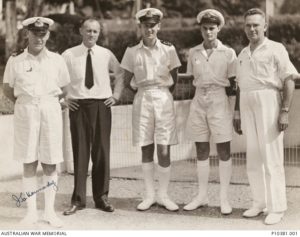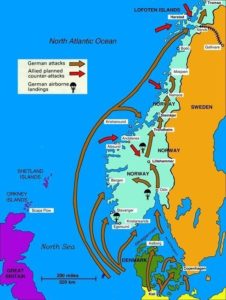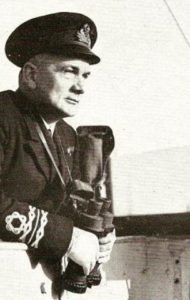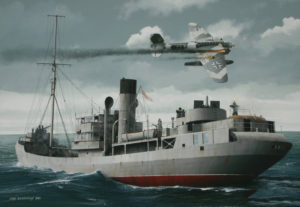- Author
- A.N. Other
- Subjects
- Biographies and personal histories, WWII operations
- Tags
-
- RAN Ships
- None noted.
- Publication
- September 2021 edition of the Naval Historical Review (all rights reserved)
By Colin Randall
Many years ago I was involved in the coal mining industry based in the Hunter region and became a member of the Newcastle Club. The club remembers those with wartime service, and Ernest Thomas Lees is noteworthy. As a Sub Lieutenant RANVR he was awarded the Distinguished Service Order. Surely this is a remarkable achievement worthy of further research. This then is his story and the part he played in the little-known Norwegian Campaign.
At this stage we know little of the early life of Ernest Thomas Lees other than he was born in Sydney on 26 November 1909. There is a Royal Australian Navy Reserve (RANR) record showing Ernest Thomas Lees S6256 carrying out 17 days annual training as an Ordinary Seaman in July 1927 and continuing similar training as an Able Seaman in 1928 and 1929. The ‘S’ prefix to his official number indicates a seagoing rating, or possibly apprentice, from the Merchant Service. There is no further record of service after this date which may relate to a dramatic reduction in numbers of naval personnel during the Great Depression.
Ten years later thirty-year-old Ernest Thomas Lees, now married to Margery and living in Double Bay, entered the Royal Australian Naval Volunteer Reserve (RANVR) as a probationary Sub-Lieutenant on 31 May 1939. After initial training he was amongst the first entry into the new anti-submarine training school known as HMAS Rushcutter. Of the 62 graduates eight were selected to be lent to the Royal Navy and in the troop transport Orcades for England.

Not long after their arrival the eight young Australians did not find themselves bound for classic cruisers or dashing destroyers, but for trawlers based at the grim granite city of Aberdeen. Excitingly, they were off to war against the Hun, not to save la belle France, but to a cold Nordic frontier.
War comes to Scandinavia
In March 1939 German troops occupied Czechoslovakia, the catalyst for the Second World War; with the invasion of Poland, Great Britain and her allies declared war upon Germany on 3 September 1939. This was followed on 9 April 1940 by another German thrust through neutral Denmark and Norway. Facing overwhelming odds, the small Danish armed forces capitulated within a matter of hours. In response British forces occupied the Danish territories of the Faroe Islands and Iceland, and the United States occupied the Danish territory of Greenland.

Norway was vital to British interests being directly opposite the east coast of England and Scotland, providing German access to the Atlantic, threatening Allied supplies through northern Russia, and giving Germany continued access to Swedish iron ore through Norwegian ports. In addition, Norway had a large merchant fleet, especially tankers, which could not be allowed to fall into enemy hands.
To counter the German invasion into Scandinavia some 25,000 British, French and Free Polish forces were inserted into Norway to assist local resistance. The campaign went badly for the Allies who had superior naval forces and roughly equal numbers of ground troops, but were hampered by inferior air power. As a result Allied forces were withdrawn by early June 1940 when the remaining Norwegian troops surrendered.
The Royal Naval Patrol Service
As part of the British preparation for war from early in the summer of 1939, the Naval Patrol Service was formed by requisitioning 400 fishing vessels with half for anti-submarine duties and the remainder for minesweeping. The boats, mostly trawlers, were fitted with a 12-pounder or 4-inch gun on the forecastle, a pair of Oerlikon or Bofors aft of the funnel and another pair of Lewis or Hotchkiss machine guns on the bridge wings. Ships destined for anti-submarine duties also had ASDIC and depth charges with throwers.
These vessels were mostly manned by fishermen who entered the RNR under five-year engagements. Certified masters of fishing vessels became Skippers equating to warrant officers and the remainder were ratings. They were augmented by RN, RNR and RNVR personnel mainly for operational, armament and communications duties. The Royal Naval Patrol Service was based at Lowestoft with its shore headquarters known as HMS Europa.
Trawlers were assigned in small groups of about four vessels with a group leader, usually an experienced seagoing RNR Lieutenant, assisted by an Executive Officer, most likely a Lieutenant or Sub Lieutenant RNR or RNVR. This was the case in HMS Arab commanded by Lieutenant Richard Been Stannard RNR, a Master Mariner and in peacetime serving as First Officer with the Orient Line. He was assisted by the freshly minted Sub Lieutenant Ernest Thomas Lees RANVR.

Arab was a typical coal burning trawler of 530 gross tons; launched in 1936, she was 52 m in length, with an 8.6 m beam and drawing 4.5 m. She was a sturdy craft with a good capacity for cargo and personnel. Her 4 cylinder compound steam engine linked to a single screw propeller could provide a respectable 12 knots. The main difference between these ships in their wartime roles was in the number of personnel required to man the considerable armament; the peacetime crew of 15 increased to over 40. Sub-Lieutenant Lees joined her on 26 February 1940 and Lieutenant Stannard relieved her Skipper of command on 20 April. With few resources available, workup was extremely limited and hardened fishing crews, which had never seen a parade ground or the benefit of naval training, were irreverently known as ‘Churchill’s Pirates’.
Norwegian Landings
The British-led Expeditionary Force had been hastily despatched to aid the resisting Norwegians with landings made atNarvik, Namsos and Andalsnes to the north and south of the main German force at Trondheim. The aim was to conduct a pincer movement on the enemy positions.
To provide anti-submarine protection to the Allied warships and transports, 29 trawlers accompanied the invaders. The A/S Strike Force was divided into a number of small groups. The 16th A/S Group comprised the trawlers Aston Villa, Gaul, Angle and Arab.
The 15th and 16th Groups which set out from Aberdeen on 24 April 1940 were assigned to Namsos which is a small town, 20 miles from the entrance, at the head of a fjord lying about halfway up the deeply indented Norwegian coastline. Namsos is quite a way north and therefore cold, lying about two degrees south of the Arctic Circle.
On Sunday 28 April 1940 Arab was leading a patrol off Namsos where some 6,500 Allied troops had been landed and supply ships were now arriving with ammunition, fuel and heavy equipment. But none remained longer than could be helped in the inferno caused by bursting bombs from ceaseless raids by high flying Dorniers and diving Stukas, who came in waves of six, nine and twelve at a time. The weaving trawlers provided protection where they could amongst the anti-aircraft fire provided by a few larger warships.
Arab had been assisting a grounded French ammunition ship and was next assigned to a fiercely burning fire on a wooden pier. Next to this were piled many hundreds of tons of vitally needed stores including grenades and other ammunition. Lieutenant Stannard ordered hoses rigged, and steamed at full speed towards the pier. For two hours the trawler stood facing the searing heat, which caused the paint on her sides to blister and burn. The munitions and part of the pier were saved, which proved invaluable at the subsequent evacuation.
Then they were dived upon by sixteen Stukas which caused the trawler to break away from the fire and seek shelter beneath an overhanging cliff. The next two days were no different with incessant bombing raids. Of the original 29 strong trawler contingent, thirteen of the vessels were either driven ashore or sunk beneath the chilly waters of the fjords, along with many of their gallant crews. The losses included Arab’s sisters Gaul and Aston Villa.
Evacuation now became the order of the day with the weary men of the Expeditionary Force and their Norwegian comrades clambering aboard warships, transports and trawlers to take them away. For five days Lieutenant Stannard had maintained his exhausted crew and fought off all attempts to sink his ship. So well planned had been his defences, and despite incessant bombing and strafing, only one man had been wounded; and whilst damaged, his ship remained seaworthy but was now down to a maximum speed of about six knots.
On leaving Norwegian waters, an enemy Heinkel medium bomber whose pilot thought he had Arab at his mercy, ordered the ship by Aldis light to return or be sunk. Stannard held his course and reserved his fire whilst the over-confident bomber came in close and at about 1,000 feet he brought the enemy aircraft down. Now at last they were leaving behind this hell on earth and a few days later reached the safety of Scapa Flow, before returning to their home port of Aberdeen. After only a few days in which to coal, take on stores and ammunition and effect repairs, Arab was on her way to Dunkirk from 26 May to 4 June 1940 assisting with the evacuation of another but much larger British Expeditionary Force from France.
Recognition
In the London Gazette of 16 August 1940 Lieutenant Richard Been Stannard RNR was cited as having been awarded the Victoria Cross ‘for outstanding valour and signal devotion to duty at Namsos’. At the same time Sub Lieutenant Ernest Lees RANVR was awarded the Distinguished Service Order for daring, resource and devotion to duty while serving in Arab. Other awards made to Arab’s gallant crew included a Conspicuous Gallantry Medal, two Distinguished Service Medals and one Mentioned in Despatches. Not recognised at the time was the tremendous debt owed to the Royal Naval Patrol Service with 260 trawlers lost to enemy action and 2,385 officers and men who ‘have no known grave but the sea’.

The exceptional career of Richard Stannard blossomed. He was promoted Lieutenant Commander and received a number of destroyer commands, was awarded a Distinguished Service Order, and made the rank of Captain RNR. He continued his merchant career as captain of an Orient liner and in 1952 came to Australia as Marine Superindent of P & O Lines Australia. He died in Sydney on 22 July 1977 and is buried at Rookwood Cemetery.
Ernest Lees was promoted to Lieutenant, backdated to 26 February 1940, and left Arab on 30 June 1940 for the A/S School HMS Osprey. He was promoted Acting Lieutenant Commander on 30 September 1943 and was appointed in command of the ML base in Trinidad. At the end of hostilities, he returned to the RAN and was discharged from the service on 23 January 1946. He was retrospectively confirmed in the rank of Lieutenant Commander RANVR on 30 June 1948. Unfortunately, we know nothing of him post war, and should be obliged for any further information on this distinguished officer.
References:
DSO Won at Namos, Navy League magazine The Navy July 1948.
Hampshire, A. C., Lilliput Fleet, New English Library, London, 1976.
Pfennigwerth, I., Bravo Zulu – Honours & Awards to Australian Naval People Vol 1 1900-1974, Echo Books, Geelong, Victoria, 2016.
Stannard, R. B., A Report on the Namsen Fjord Actions, Royal Naval Patrol Service, Retrieved 2 June 1921.
Lieutenant R. B. Stannard VC, HMS Arab and the Norwegian Campaign, NHR December 2001.
Worledge, G. R. (Ed), Contact: HMAS Rushcutter & Australia’s Submarine Association 1939-1946, The Anti-Submarine Officers’ Association, Sydney, 1995.




